Christmas Facts & History
CHRISTMAS
CRACKERS were invented in the 19th
century by a baker called Tom Smith. While he was on holiday in France he
noticed that bonbons were wrapped in colored paper, twisted at each end, he
thought this was a good idea. When he returned to England he opened a factory
and started to make them. After a while he included a chemically treated piece
of card which exploded when the cracker was pulled. The ‘crackers’ were a huge
success and soon they were being filled with small toys and romantic messages.
By 1900 he was selling 13 million crackers worldwide each year.
Are these sentences true or false?
1. Mr Smith lived in France.
2. He got inspiration from wrapped bonbons.
3. The first cracker exploded.
4. Crackers are filled with surprises.
5. Crackers have & still are a huge success.
CHRISTMAS
CAROLS date from the 12th
century. They were simple songs, danced to on festive occasions. In time the
Church gave them religious significance by checking the words. By the 16th
century carols were being sung in almost every European language. However this
almost came to an end when the Reformation, followed by Puritanism, destroyed
the carol tradition except for those in Roman Catholic countries. Carols were
revived in the 19th century and soon became known as Christmas Hymns
often sung by wandering musicians called carol-singers.
Answer the following in full sentences:
1. When did carols start?
2. Who gave them religious
significance?
3. When did Europeans start singing carols?
4. Who destroyed the carol tradition?
5. When were carols revived again?
6. What were they called?
7. Who used to sing them?
8. Do you sing carols at Christmas?
CHRISTMAS
PUDDINGS were nothing like the fruity
and sweet dessert we have today. Instead the dish was a type of porridge. It
tended to be a soupy and savory dish made with beef, mutton, prunes, raisins,
spices and wine. In poorer households sometimes a thick version of this dish
was eaten to fill stomachs before a meagre serving of meat, including at
Christmas. The dish started to become more like the dessert we know now by
the end of the 16th century as it became sweeter and was thickened into
something like a pudding.
Are these sentences true or false?
1. Christmas pudding has always been sweet.
2. Christmas pudding used to have meat.
3. It was something like soup.
4. At the end of 17th century the pudding was
sweet.
5. Christmas pudding is delicious.
CHRISTMAS
CARDS are quite a new invention. The
first one was produced in 1846 showing a family raising their glasses to toast
the festive season. Every year more and more cards were sold, particularly
after the introduction of the halfpenny postage stamp in 1870. Sales of cards
boomed and ten years later in 1880, the post office started issuing the now
familiar message ‘Post early for Christmas’. The first cards were often simply
decorated but soon they were followed by cards showing robins, angels and
nativity scenes. Many people today send cards showing snow covered scenes of a
rural past, even though it rarely snows in Britain at Christmas.
Answer the following in full sentences
1. When
was the first card made?
2.
What did they have on them?
3.
When were more cards sold?
4. “Post
early for xmas” started in?
5.
What did the first cards look like?
6.
How did they look after some time?
7.
What do cards look like today?
8.
Does it always snow in England during Christmas?
9.
Have you ever seen a white Christmas?
10.
Do you send or receive cards?
Santa
Claus, also known as Father Christmas is
a figure which comes from the Dutch figure of Sinterklaas. He is a historical
figure who brings gifts to the homes of the good children during the
late evening and overnight hours of Christmas Eve, December the 24th . The
legend is based on the tales concerning the historical figure of gift giver
Saint Nicholas. While Saint Nicholas was originally portrayed wearing bishop's
robes, today Santa Claus is described as a plump, jolly, white-bearded man
wearing a red coat with white collar and cuffs, white-cuffed red trousers, and
black leather belt and boots. This image became popular in the United States
and Canada in the 19th century due to the influence of caricaturist and
political cartoonist Thomas Nast. In the United Kingdom and Europe, he is
identical to the American Santa Claus, but he is commonly called Father
Christmas.
Answer these questions in full sentences
after reading the story above:
1. Where does the name Santa Claus come from?
2. What does he do?
3. When does his job start?
4. What was the name of the gift giver?
5. What did Saint Nicholas wear?
6. Describe Santa?
7. Who drew Santa & when?
8. Does Santa look the same everywhere?
9. What is he called in the UK?
10. Has Father Christmas visited you?









Оставьте свой комментарий
Авторизуйтесь, чтобы задавать вопросы.